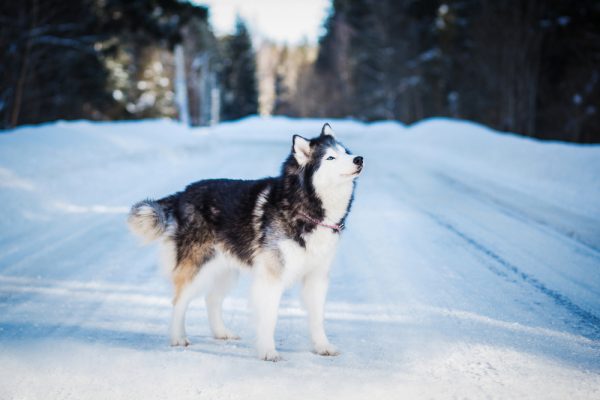
The first three rules of dog sledding are simple:
#1: Don’t let go.
#2: Don’t let go.
#3: Don’t let go.
The Internet is replete with lists of the best breeds for sled dog work, and not surprisingly, they include the Greenland Dog, Chinook, the Yakutian Laika, and various huskies. One breed often seen on some lists, however, is one that probably shouldn’t be there, and that is the Alaskan Malamute. This isn’t to say the breed wasn’t, and isn’t, used as a sled dog, but it’s more accurate to say that the breed was originally bred to have the strength and endurance to haul heavy freight on a travois, or drag sled. Many researchers believe that travois were used in some parts of the world even before the invention of the wheel, and there is evident to support the notion.
A travois is a simple platform of planks or netting mounted on two long poles fastened in the shape of an elongated isosceles triangle. The frame would lashed one on either side of a dog (later, a horse) with the end of each pole dragging behind on the ground.

If we can digress for a moment. An Inuit people who called themselves “Mahlemiuter” settled along the shores of Kotzebue Sound in the upper western regions of Alaska. Over centuries, they developed the dogs from which the Malamute descended. Today, these people are called the Kuuvangmiut or Kobuk people, but the dog their ancestors relied upon retains the name of those people, “Mahlemute,” “Mahlemuit,” and more commonly, Malamute.
In the interest of more, not less information, some discount the northerly Mahlemiuts as having created the breed and believe that the Malamute may have developed in coastal regions further South. It wasn’t uncommon for people and their dogs to go where the food was, so this is possible.
Wherever the breed developed, it was Malamute power + the travois that moved things along. Even after the wheel came along, a sledge dog pulling supplies was still how most things were transported because wheels were expensive to buy, and it took a special skill set to be able to make one.
In the summer of 1984, the Alaskan Malamute Club of America honored the tradition of their breed by adopting a set of weight pull rules. Malamutes love to pull, and in 2017, a two year old 150 pound Malamute named “Delbert” broke a track record by pulling 5,400 pounds. Delbert really liked to pull.
We came across the photo below that appeared in a blog named, Born to Pull written by Joe Henderson of Alaskan Arctic Expeditions. The article contains wonderful photos, but this one shows “Farmer,” “Bear” and “Boss” leading a 21-dog team that’s pulling a 2,500 lb. load of supplies in Alaska’s arctic. Mr. Henderson takes a team of 22-24 purebred Malamutes into Alaska’s arctic on remote dog sledding expeditions to explore the rugged country and facilitate his dogs’ working in a freighting capacity. In late February of 2021, he took another dog sled expedition to the Alaskan Arctic and has plans to publish a photo journal book in the fall of 2021. Until it comes out, we encourage you to “rummage” around his site. If you love the Alaskan Malamute and have an interest in the job the breed was bred to do, you’ll enjoy it. Henderson, as an aside, was the coordinator and trainer of 23 sled dogs for the movie, White Fang.

